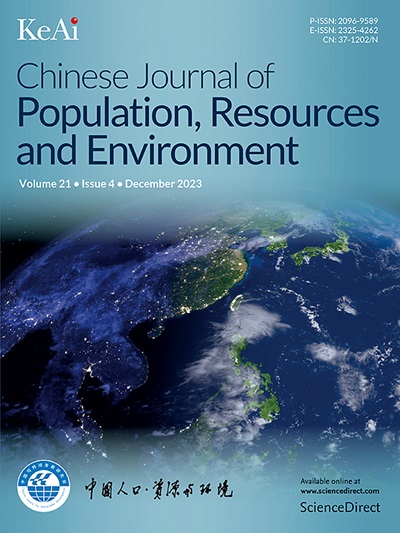Global greenhouse gas emissions in the 21st century: Complex network, driver pattern and economy-based interaction
IF 4.8
4区 环境科学与生态学
Q2 ENVIRONMENTAL STUDIES
Chinese Journal of Population Resources and Environment
Pub Date : 2025-06-01
DOI:10.1016/j.cjpre.2025.05.002
引用次数: 0
Abstract
Achieving a reduction in global greenhouse gas (GHG) emissions requires collaborative efforts from the international community; however, a comprehensive understanding of the spatiotemporal characteristics (i.e., complex emission networks and driver patterns) and the mutual influence of gross domestic product (GDP) and GHG emissions remains limited at a global level in the 21st century, which is not conducive to forming a consensus in global climate change negotiations and formulating relevant policies. To fill these gaps, this study comprehensively analyzes the complex network and driver pattern of GHG emissions, as well as the corresponding mutual influence with GDP for 185 countries during 2000–2021, based on social network analysis, the logarithmic Divisia decomposition approach, and panel vector autoregression model at global and regional levels. The results indicate that significant heterogeneity and inequality exist in terms of GHG emissions among regions and countries in different geographical areas and economic income levels. Additionally, GDP per capita and GHG emission intensity are the largest positive and negative drivers, respectively, affecting the increase in global GHG emissions. Furthermore, key countries, such as Germany and Canada, that could serve as coordinating bridges to strengthen collaboration in the global emission network are identified. This study highlights the need to encourage key participants in the emission network and foster international cooperation in governance, energy technology, and economic investment to address climate change.
21世纪全球温室气体排放:复杂网络、驱动模式和基于经济的相互作用
实现全球温室气体(GHG)排放的减少需要国际社会的合作努力;然而,在21世纪的全球范围内,对国内生产总值(GDP)和温室气体排放的时空特征(即复杂的排放网络和驱动模式)及其相互影响的全面认识仍然有限,这不利于在全球气候变化谈判中形成共识和制定相关政策。为了填补这些空白,本研究基于社会网络分析、对数除法分解方法和面板向量自回归模型,综合分析了2000-2021年185个国家温室气体排放的复杂网络和驱动模式,以及与GDP的相互影响。结果表明,不同地理区域和经济收入水平的地区和国家间温室气体排放存在显著的异质性和不平等。此外,人均GDP和温室气体排放强度分别是影响全球温室气体排放增加的最大正驱动因素和负驱动因素。此外,还确定了德国和加拿大等可以作为加强全球排放网络合作的协调桥梁的关键国家。本研究强调,有必要鼓励排放网络的主要参与者,并促进治理、能源技术和经济投资方面的国际合作,以应对气候变化。
本文章由计算机程序翻译,如有差异,请以英文原文为准。
求助全文
约1分钟内获得全文
求助全文
来源期刊

Chinese Journal of Population Resources and Environment
ENVIRONMENTAL STUDIES-
CiteScore
4.30
自引率
1.10%
发文量
791
审稿时长
79 days
期刊介绍:
The Chinese Journal of Population, Resources and Environment (CJPRE) is a peer-reviewed international academic journal that publishes original research in the fields of economic, population, resource, and environment studies as they relate to sustainable development. The journal aims to address and evaluate theoretical frameworks, capability building initiatives, strategic goals, ethical values, empirical research, methodologies, and techniques in the field. CJPRE began publication in 1992 and is sponsored by the Chinese Society for Sustainable Development (CSSD), the Research Center for Sustainable Development of Shandong Province, the Administrative Center for China's Agenda 21 (ACCA21), and Shandong Normal University. The Chinese title of the journal was inscribed by the former Chinese leader, Mr. Deng Xiaoping. Initially focused on China's advances in sustainable development, CJPRE now also highlights global developments from both developed and developing countries.
 求助内容:
求助内容: 应助结果提醒方式:
应助结果提醒方式:


